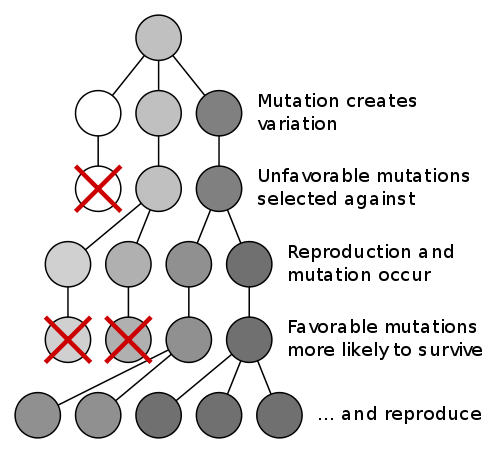
Mutation followed by natural selection favouring darker dots. Over time darker dots dominate the population.
The basic idea of natural selection follows from three observations:
In each generation there are small variations between organisms. Some of these variations help an organism to survive and reproduce, while others are either neutral or detrimental.
Organisms tend to produce more offspring than can possibly survive.[1] Because there is limited food and space, there is competition between organisms for these finite resources.
Those organisms with advantageous variations are more likely to survive and have offspring than those with less helpful characteristics. In turn those offspring have a better chance to reproduce. In this way useful traits become more common in a population and bad ones die off.
Traits that help an organism survive and reproduce are "selected for" in nature, just as an animal breeder selects bigger cattle to breed so that their offspring yield more meat.[2]
Before natural selection was discovered, other mechanisms for evolution had been suggested. Alternatives to natural selection included inheritance of acquired characteristics (neo-Lamarckism), an innate drive for change (orthogenesis), and sudden large mutations (championed by Hugo de Vries).
Evolution was clearly in the air, because in 1844 Robert Chambers had published (anonymously) Vestiges of the Natural History of Creation, but it was not argued substantially enough and it was shot down by academics of the time.
Charles Darwin conceived the idea of natural selection in 1838 and wrote the idea up in an essay of 1844. However he did not publish for many years, until in 1858 he received a paper by Alfred Russell Wallace, which also set out the idea of natural selection. To preserve their honour, papers by both authors were presented together to the Linnean Society of London on 1 July 1858. The joint presentation was called On the Tendency of Species to form Varieties; and on the Perpetuation of Varieties and Species by Natural Means of Selection.
The idea of natural selection is also known as survival of the fittest, a phrase coined by Herbert Spencer.
Favourable variations might be blended out by backcrossing with normal strains. Solved by Mendel's work on inheritance and then DNA.
As Malthus had initially observed, populations tend to reproduce exponentially if unchecked.
Darwin had already observed artificial selection by animal and plant breeders, who weed out strains they don't like. In fact in The Origin of Species he introduces selection by its artifical counterpart, before explaining that it also happens naturally. Whereas farmers select for higher yields, nature selects for survivability.
Author: Tom Brown
Copyright: public domain
Date last modified: 13th Oct 2011
Peer-review status: Not yet peer-reviewed
Natural selection tree: source: Wikipedia, copyright: CC, Attribution Share Alike